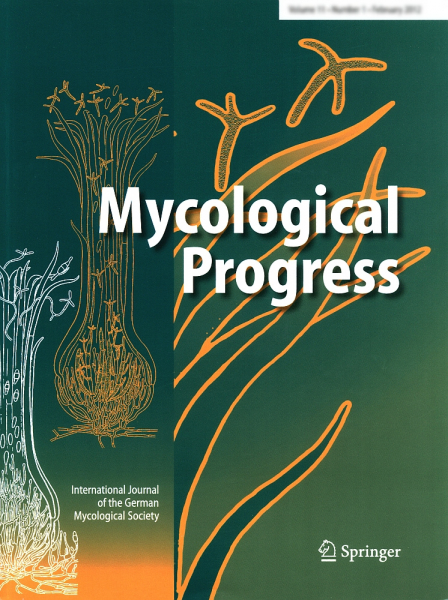Mit 20 wissenschaftlichen Beiträgen aus der globalen Wunderwelt der Pilze bietet die „Mycological Progress“ auch im 4. Quartal wieder interessanten und fundierten Lesestoff.
Die beiden Open-Access-Artikel behandeln den Komplex der Bläulichgrauen Wachsrinde Basidiodendron caesiocinereum (ab Seite 1.275) und neue nordamerikanische Taxa aus der Cortinariengruppe Anomali (ab Seite 1.399). Sie beinhalten jeweils Übersichten zur Phylogenie, aktuelle Schlüssel und ausführliches Bildmaterial.
Über die Mycological Progress
Mycological Progress ist die von der Deutschen Gesellschaft für Mykologie seit 2002 herausgegebene internationale Fachzeitschrift, die Beiträge über alle Teilgebiete der Mykologie, einschließlich der Flechten, in englischer Sprache publiziert. Primärer Gegenstand sind Originalarbeiten über Taxonomie, Systematik, Evolution, Zellbiologie, Ökologie, Pathologie (Pflanzen, Tiere, Mensch), Symbiose und Biotechnologie. Die Zeitschrift wird von Springer verlegt und seit 2015 als reines Online-Journal publiziert (12 Ausgaben pro Jahr). Mindestens ein Artikel in jeder Ausgabe ist frei auf der Verlags-Website zugänglich (Open Access) und somit für alle Interessierten kostenlos erhältlich.
Band 20, Ausgabe 10, Oktober 2021
-
Yong Nie, Zi-Min Wang, Xiao-Yong Liu, Bo Huang: A morphological and molecular survey of Neoconidiobolus reveals a new species and two new combinations – Seite 1233
-
Lu-Ling Wu, Zhi-Qun Liang, Ming-Sheng Su, Yu-Guang Fan, Ping Zhang, Shuai Jiang, Yan-Liu Chen, Yan-Jia Hao, Nian-Kai Zeng: Updated taxonomy of Chinese Phylloporus (Boletaceae, Boletales): six new taxa and four redescribed species – Seite 1243
-
Viacheslav Spirin, Vera Malysheva, Nathan Schoutteten, Ilya Viner, Otto Miettinen, Jenni Nordén, Leif Ryvarden, Heikki Kotiranta, Annemieke Verbeken, Michael Weiß, Karl-Henrik Larsson: Studies in the Basidiodendron caesiocinereum complex (Auriculariales, Basidiomycota) – Seite 1275, diesen Beitrag kostenlos abrufen
-
Yi-Chung Lin, Chia-Ling Wei, Chi-Yu Chen, Che-Chih Chen, Sheng-Hua Wu: Three new species of Cylindrobasidium (Physalacriaceae, Agaricales) from East Asia – Seite 1297
-
A. L. Gallo, P. V. Silva, P. López Bernal, A. S. Moretto, A. G. Greslebin: Fungal diversity, woody debris, and wood decomposition in managed and unmanaged Patagonian Nothofagus pumilio forests – Seite 1309
-
Danny Haelewaters, Duckchul Park, Peter R. Johnston: Multilocus phylogenetic analysis reveals that Cyttariales is a synonym of Helotiales – Seite 1323
-
Md. Kamaruzzaman, Md. Samiul Islam, Md. Amit Hasan, Razia Sultana, Mohammad Omar Faruque, Chunhao Jiang: Characterization of a hypovirulent strain of Botrytis cinerea from apple and quantification of the ICs related gene expression – Seite 1331
-
Hao Zhou, Qiu-Tong Wang, Xin Tong, Cheng-Lin Hou: Phylogenetic analysis of Engleromyces sinensis and identification of cytochalasin D from culture – Seite 1343
-
M. B. Govinda Rajulu, T. S. Suryanarayanan, T. S. Murali, N. Thirunavukkarasu, G. Venkatesan: Minor species of foliar fungal endophyte communities: do they matter? – Seite 1353
-
Mohamed A. Abdel-Wahab, Ali H. Bahkali, Abdallah M. Elgorban, E. B. Gareth Jones: High-throughput amplicon sequencing of fungi and microbial eukaryotes associated with the seagrass Halophila stipulacea (Forssk.) Asch. from Al-Leith mangroves, Saudi Arabia – Seite 1365
Band 20, Ausgabe 11, November 2021
-
Bing-Da Sun, Cobus M. Visagie, Amanda Juan Chen, Jos Houbraken: A taxonomic review of Penicillium section Charlesia – Seite 1383
-
Bálint Dima, Kare Liimatainen, Tuula Niskanen, Dimitar Bojantchev, Emma Harrower, Viktor Papp, László G. Nagy, Gábor M. Kovács, Joseph F. Ammirati: Type studies and fourteen new North American species of Cortinarius section Anomali reveal high continental species diversity – Seite 1399, diesen Beitrag kostenlos abrufen
-
Eugénio Diogo, Catarina I. Gonçalves, Ana C. Silva, Carlos Valente, Helena Bragança, Alan J. L. Phillips: Five new species of Neopestalotiopsis associated with diseased Eucalyptus spp. in Portugal – Seite 1441
-
Sarah Silva Costa Guimarães, Dérica Gonçalves Tavares, Mônica Cristina Pereira Monteiro, Márcio Pozzobon Pedroso, Cleiton Antônio Nunes, Bárbara Mourão, Iago Silva e Carvalho, Danae Kala Rodríguez Bardají, Ilana Lopes Baratella Cunha Camargo, Ubiraci Gomes Paula Lana, Eliane Aparecida Gomes, Marisa Vieira Queiroz, Olinto Liparini Pereira, Patrícia Gomes Cardoso: Polyphasic characterization and antimicrobial properties of Induratia species isolated from Coffea arabica in Brazil – Seite 1457
-
Karen K. Nakasone, Beatriz Ortiz-Santana, Shuang-Hui He: Taxonomic studies of crust fungi with spines in Radulomyces, Sarcodontia, and the new genus Noblesia – Seite 1479
Band 20, Ausgabe 12, Dezember 2021
-
Hans-Otto Baral, Peter Johnston, Luis Quijada, Rosanne Healy, Donald H. Pfister, Katherine F. LoBuglio, Valentina Rodriguez, Evi Weber: Cryptic speciation in Orbilia xanthostigma and O. leucostigma (Orbiliomycetes): an aggregate with worldwide distribution – Seite 1503
-
Lei Su, Hua Zhu, Peilin Sun, Xue Li, Bochao Yang, Hong Gao, Zhiguang Xiang, Chuan Qin: Species diversity in Penicillium and Acaulium from herbivore dung in China, and description of Acaulium stercorarius sp. nov. – Seite 1539
-
Miroslav Kolařík, I-Chin Wei, Sung-Yuan Hsieh, Meike Piepenbring, Roland Kirschner: Nucleotide composition bias of rDNA sequences as a source of phylogenetic artifacts in Basidiomycota — a case of a new lineage of a uredinicolous Ramularia-like anamorph with affinities to Ustilaginomycotina – Seite 1553
-
Chang Xu, Zhi-Qun Liang, Hui-Jing Xie, Shuai Jiang, Xin-Hua Fu, Nian-Kai Zeng: Two new species of Chalciporus (Boletaceae, Boletales) from tropical China – Seite 1573
-
Fábio A. Custódio, Thiago C. Brommonschenkel, Athus D. A. Silva, Olinto L. Pereira: Colletotrichum pereskiae sp. nov. causing anthracnose on Pereskia aculeata in Brazil – Seite 1583
Bezug und Benachrichtigung
Die Mycological Progress ist über die Website des Springer-Verlags per Subscription verfügbar. Die Rechnungen und den persönlichen Zugangscode erhalten Abonnenten direkt vom Verlag. Dort wird auch ein kostenfreier Benachrichtigungsservice angeboten, der über neue Ausgaben des Online-Journals per E-Mail informiert.
Wir wünschen viel Vergnügen bei der Lektüre der Mycological Progress!



